When we think of ergonomics, we often think of the equipment we wear, hold, or sit upon. However, the equipment that surrounds us can have just as great an impact as the equipment that is in constant contact with our bodies. The dental patient chair can greatly impact operator posture and must allow close positioning for the dentist. Poorly designed models can cause a forward leaning posture and excessive forward reaching with the arms. On the other hand, delivery systems impact the operator’s body mechanics and can result in movement dysfunction, shoulder joint, or low back problems.
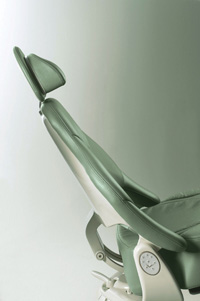 |
| Figure 1. A very thin back, with a magnetic headrest (UltraTrim Chair [Midmark]). |
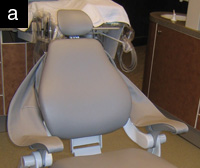 |
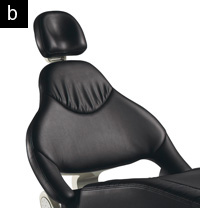 |
| Figure 2. Two styles of ergonomic backrests that allow the operator to gain close positioning in the 9 to 11 o’clock positions: (2a) J/V-Generation Chair (DentalEZ), (2b) UltraTrim Chair (Midmark). |
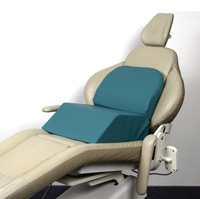 |
| Figure 3. Positioning aids, such as this pedo booster, help keep the head properly positioned in the headrest, optimizing access to the oral cavity (Crescent Dental Products). |
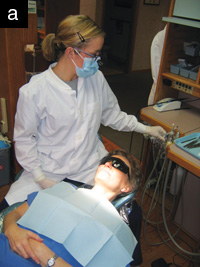 |
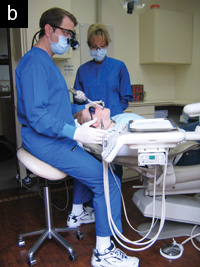 |
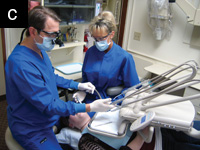 |
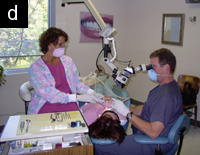 |
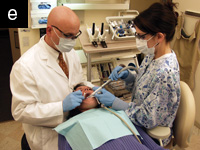 |
|
Figure 4. Five types of delivery systems that address different needs. From left to right: (4a) rear delivery; (4b) side delivery; (4c) over-the-patient delivery; (4d) transthorax delivery; and (4e) over-the-head delivery. |
PATIENT CHAIRS: CLOSE PROXIMITY IS KEY
For decades, the focus of many dental chair manufacturers has been on patient comfort: luxuriously cushy with wide, roomy armrests. However, when we compare how many hours a year the average patient spends reclined in a dental chair (up to several hours), with the time you spend hovering over the oral cavity (more than 2,000 hours), who is really at risk of developing discomfort and/or pain?
As the problem of work-related pain and injuries among dentists has come to the forefront in the profession, manufacturers are increasingly focusing on the ergonomic features of patient chairs. But what, exactly, are desirable “ergonomic features”? When considering patient chair ergonomics, desirable features should facilitate neutral posture of the spine, shoulder, elbow, and wrist; and excessive reaching should be limited. I often observe operators having difficulty gaining close proximity to the oral cavity while maintaining a neutral posture. If the patient chair does not allow close operator positioning, the dentist is forced to either reach excessively forward with the entire arm, or to bend the trunk forward. Both place the operator at risk for injury. The following are important ergonomic criteria for patient chair selection:
Small and Thin Headrests
These allow for more legroom and easier/enhanced accessibility to the patient. Double-articulating and magnetic headrests will allow greater flexibility in patient positioning. Large knobs behind headrests can hit your knees or the edge of your operator stool and thus inhibit close positioning. Double-articulating headrests allow for both rotation and tilt of the patient’s head. The double articulation feature can greatly aid in viewing the upper arch by allowing the headrest to be angled up into the patient’s occiput, so that the nose and chin are approximately level. For the lower arch, this feature allows the headrest to be angled forward and down, so that the chin is lower than nose level. A common ergonomic problem I observe is when the headrest is left flat for all procedures, and the time is not taken to properly angle it to more easily view the desired arch. Magnetic headrests, on a flat and thin headrest, also allow side bending of the patient’s head to further increase proximity (Figure 1). Most ergonomic patient chairs offer the option of either headrest style.
Narrow Upper Backrest
Since movement around the patient’s head is important to your health,1 a narrow profile backrest is desirable. Many patient chairs on the market now have thin upper backrests, but are still quite wide through the shoulder area. This inhibits close positioning, especially at the 9 to 10 o’clock positions. A narrow upper backrest allows for easy movement around the head of the patient from 9 to 11 o’clock.2 It will also benefit assistants by allowing closer positioning (Figures 2a and 2b).
Adjustability
Headrests should be adjustable in order to be able to accommodate different patient sizes and needs. Tall patients will need a longer extension on the headrest, and geriatric patients with kyphotic head posture will need support of the head in a forward position. Patient positioning aids can be very helpful when treating pedo patients, in order to keep the head properly positioned in the headrest for optimal accessibility (Figure 3).
Sling-Style or Low-Profile Armrests
These features will help you to work in the 8 to 10 o’clock positions without hitting your knees on a fixed-metal armrest.
Height Adjustment
The chair should adjust low enough to allow the dentist to operate in a neutral seated posture, especially when the patient is in a semisupine position. When patient chairs do not adjust low enough, shorter operators are forced to either perch on the edge of their chair or elevate their arms. Rather than replace the patient chair, an easier solution to this problem is to use a saddle stool, placing the dentist halfway between standing and sitting. The chair should also
adjust to a position that is high enough for the dentist to have the option to comfortably stand for extractions, exams, or impression taking without excessive forward bending.
Swivel Feature
The chair should be able to rotate in the operatory to allow access around the patient’s head. This becomes an important feature if the space between the patient headrest and counter is minimal.
Base Location
A base positioned more toward the foot of the patient chair is less likely to become an obstruction by hitting the operator stool pedestal.
Chair Length
Patient chair length is a frequently overlooked consideration when purchasing a new chair. Many operatories are quite small and cannot accommodate certain chair models. Strive for a minimum of 24 inches between the top of the patient chair headrest (when fully reclined) and the counter, so you can easily move into the 12 o’clock position. A chair with a “traverse” feature will allow the chair to glide horizontally back and forth to easily adjust this distance.
DELIVERY SYSTEMS: DIFFERENT STYLES FOR DIFFERING NEEDS
Each delivery system has its pros and cons and can profoundly impact the operator’s musculoskeletal health and productivity—either positively or negatively. Some are better suited to 4-handed operatories, some work best for taller operators and others lend themselves well to higher productivity. Understanding these differences can help you select the right system for your team.3
Rear-Delivery Systems
These systems can accommodate all clinical instruments behind the patient, freeing up space for other larger pieces of equipment in the operatory. These are the least expensive, and they also keep the equipment out of view of the patient which will decrease anxiety. Functionally, rear delivery works fairly well when true 4-handed dentistry is practiced, but it is the poorest method of delivery in 2-hand function. More often than not, rear-delivery systems encourage operators to extensively reach, lean, or twist their torsos to retrieve instruments from behind the patient’s head, which can contribute to low-back pain.4,5 Operators should try to retrieve instruments with the closest (nondominant) hand to avoid repeated twisting or reaching across the body, and then transfer the instrument to the dominant hand (Figure 4a).6 The ability to frequently reposition and move around the patient’s head is imperative for the operator’s musculoskeletal health. Some rear-delivery systems limit access from 11 to 12 o’clock positions, which generally offer the best ergonomic access during a procedure.
Side-Delivery Systems
These systems require less trunk-twisting than rear delivery for the doctor to retrieve instruments (Figure 4b). Since the assistant cannot reach the instruments, productivity may often be compromised. In addition, the dentist must also remember to squarely face the system when changing burs, rather than sustaining a twisted posture. Side-delivery systems work especially well in 2-handed operatories.
One problem I see, with dentists who use side delivery, is the tendency to “lock” into one working position relative to the patient.6 Doing this will tend to overwork/fatigue certain areas of the body and can lead to pain. The best practice with any delivery system is to change positions as frequently as possible during procedures.
Proximity of the system is also a concern. Often, as operators move around the patient’s head, they do not reposition the side-delivery system, repeatedly leaning and/or twisting to one side to retrieve instruments. Keep in mind that, from a resale perspective, most side-delivery units are not interchangeable for left-right handed dentistry.
Over-the-Patient Delivery Systems
These delivery systems allow the doctor to move freely from the 8 to 12 o’clock positions around the patient’s head. The unit is on an arm that extends over the chest of the patient, so that handpieces and other instruments are within easy reach for both dentist and assistant, thus minimizing movement and shift of vision (Figure 4c). However, this system is highly visible and in close proximity to the patient. It may also be bumped by the patient, making it undesirable for most pedodontic offices.
For operators with shorter torsos, the system may require repeated upward reaching at the shoulder, an ergonomic risk factor for shoulder pain. Also, for your assistant’s health, do not position the system too far down the patient’s stomach, since this will cause your assistant to have to twist to retrieve instruments. These systems can easily be designed to flexibly convert for use with right- and left-handed operators.
Transthorax Delivery Systems
These delivery systems are often confused with over-the-patient systems, however, the placement and usage of each differs significantly; namely there is no support arm that extends over the patient and the handpiece tubing is transferred and retracted along the top of the unit cover. The transthorax unit design (Figure 4d) is positioned at the patient’s left side and designed to fully utilize the expanded duties (functions) of an assistant to maximize productivity.
The mobile cabinet provides the work surface, and acts as the supply and organizing center within easy reach of the assistant. The assistant retrieves and transfers handpieces from the unit to the doctor. This allows the dentist his/her eyes focused on the operating site. This type of unit has been designed for the practice of true 4-handed dentistry.7 Health Science Products manufactures the only transthorax unit available (hspinc.com).
Over-the-Head Delivery Systems
These systems have recently become recognized as a unique solution to dental delivery3 (Figure 4e). Combining many of the benefits of over-the-patient and rear-delivery systems, over-the-head systems allow the operator the ability to practice from the 7 to 1 o’clock positions. Supplies are in an ideal position for access to the assistant and handpieces are more accessible than with rear-delivery layouts. This reduces the ergonomic challenges when in 2-hand function. Additionally, over-the-head layouts, when properly configured, convert from right- to left-hand function rapidly. Designed by Dr. David Ahearn, these units are manufactured by Ergonomic Products (ergonomic-products.com).
CONCLUSION
Ergonomic features found in well-designed patient chair and dental delivery systems are of paramount importance to the comfort and health of the dentist and the dental team. When a dentist buys equipment that fails to incorporate proper ergonomic design, they only have 2 choices: to live with it and suffer the associated musculoskeletal discomfort and/or injuries; or, to buy new equipment and try to sell the old. Neither is an attractive option. It makes more sense to do the research and invest in equipment that will benefit your health and extend your career right from the start!
References
- Valachi B, Valachi K. Mechanisms leading to musculoskeletal disorders in dentistry. J Am Dent Assoc. 2003;134:1344-1350.
- Hokwerda O, Wouters JA, de Ruijter RA, et al. Ergonomic requirements for dental equipment. Guidelines and recommendations for designing, constructing and selecting dental equipment. May 2006. Availab
le at: http://www.optergo.com/images/Ergonomic_req_april2007.pdf. Accessed May 6, 2009. - An Introduction to Ergonomics: Risk Factors, MSDs, Approaches and Interventions. A Report of the Ergonomics and Disability Support Advisory Committee (EDSAC) to Council on Dental Practice. American Dental Association, 2004. Available at: http://www.ada.org/prof/prac/wellness/ergonomics_paper.pdf. Accessed May 6, 2009.
- Torén A. Muscle activity and range of motion during active trunk rotation in a sitting posture. Appl Ergon. 2001;32:583-591.
- van Dieën J. Asymmetry of erector spinae muscle activity in twisted postures and consistency of muscle activation patterns across subjects. Spine. 1996;21:2651-2661.
- Valachi B. Can delivery systems deliver pain? Dental Practice Report 2006; 6:60-62.
- Finkbeiner BL. Four-Handed Dentistry: A Handbook of Clinical Application and Ergonomic Concepts. Upper Saddle River, NJ: Prentice Hall; 2001.
Ms. Valachi is a physical therapist, dental ergonomic consultant, and CEO of Posturedontics, a company that provides research-based dental ergonomic education. Clinical instructor of ergonomics at OHSU School of Dentistry in Portland, Ore, she is a member of the National Speakers Association, and lectures internationally at dental meetings, schools, associations and study clubs. Ms. Valachi covers the above topics and much more in her new book, Practice Dentistry Pain-Free: Evidence-based Strategies to Prevent Pain and Extend Your Career, is available through the Web site at posturedontics.com, or by calling (503) 291-5121. She welcomes comments and can be reached at bethany@posturedontics.com.
Disclosure: Ms. Valachi periodically receives partial lecture sponsorship from Midmark, Dental EZ, and Crescent Products.



